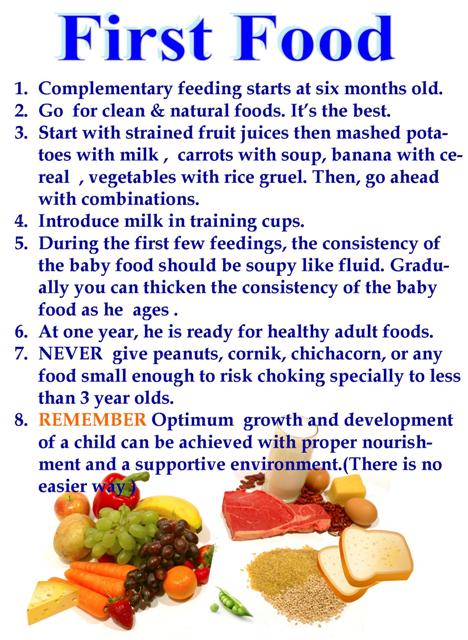Starting my baby on food
When, What, and How to Introduce Solid Foods | Nutrition
For more information about how to know if your baby is ready to starting eating foods, what first foods to offer, and what to expect, watch these videos from 1,000 Days.
The Dietary Guidelines for Americans and the American Academy of Pediatrics recommend children be introduced to foods other than breast milk or infant formula when they are about 6 months old. Introducing foods before 4 months old is not recommended. Every child is different. How do you know if your child is ready for foods other than breast milk or infant formula? You can look for these signs that your child is developmentally ready.
Your child:
- Sits up alone or with support.
- Is able to control head and neck.
- Opens the mouth when food is offered.
- Swallows food rather than pushes it back out onto the chin.
- Brings objects to the mouth.
- Tries to grasp small objects, such as toys or food.
- Transfers food from the front to the back of the tongue to swallow.
What Foods Should I Introduce to My Child First?
The American Academy of Pediatrics says that for most children, you do not need to give foods in a certain order. Your child can begin eating solid foods at about 6 months old. By the time he or she is 7 or 8 months old, your child can eat a variety of foods from different food groups. These foods include infant cereals, meat or other proteins, fruits, vegetables, grains, yogurts and cheeses, and more.
If your child is eating infant cereals, it is important to offer a variety of fortifiedalert icon infant cereals such as oat, barley, and multi-grain instead of only rice cereal. Only providing infant rice cereal is not recommended by the Food and Drug Administration because there is a risk for children to be exposed to arsenic. Visit the U.S. Food & Drug Administrationexternal icon to learn more.
How Should I Introduce My Child to Foods?
Your child needs certain vitamins and minerals to grow healthy and strong.
Now that your child is starting to eat food, be sure to choose foods that give your child all the vitamins and minerals they need.
Click here to learn more about some of these vitamins & minerals.
Let your child try one single-ingredient food at a time at first. This helps you see if your child has any problems with that food, such as food allergies. Wait 3 to 5 days between each new food. Before you know it, your child will be on his or her way to eating and enjoying lots of new foods.
Introduce potentially allergenic foods when other foods are introduced.
Potentially allergenic foods include cow’s milk products, eggs, fish, shellfish, tree nuts, peanuts, wheat, soy, and sesame. Drinking cow’s milk or fortified soy beverages is not recommended until your child is older than 12 months, but other cow’s milk products, such as yogurt, can be introduced before 12 months. If your child has severe eczema and/or egg allergy, talk with your child’s doctor or nurse about when and how to safely introduce foods with peanuts.
How Should I Prepare Food for My Child to Eat?
At first, it’s easier for your child to eat foods that are mashed, pureed, or strained and very smooth in texture. It can take time for your child to adjust to new food textures. Your child might cough, gag, or spit up. As your baby’s oral skills develop, thicker and lumpier foods can be introduced.
Some foods are potential choking hazards, so it is important to feed your child foods that are the right texture for his or her development. To help prevent choking, prepare foods that can be easily dissolved with saliva and do not require chewing. Feed small portions and encourage your baby to eat slowly. Always watch your child while he or she is eating.
Here are some tips for preparing foods:
- Mix cereals and mashed cooked grains with breast milk, formula, or water to make it smooth and easy for your baby to swallow.
- Mash or puree vegetables, fruits and other foods until they are smooth.

- Hard fruits and vegetables, like apples and carrots, usually need to be cooked so they can be easily mashed or pureed.
- Cook food until it is soft enough to easily mash with a fork.
- Remove all fat, skin, and bones from poultry, meat, and fish, before cooking.
- Remove seeds and hard pits from fruit, and then cut the fruit into small pieces.
- Cut soft food into small pieces or thin slices.
- Cut cylindrical foods like hot dogs, sausage and string cheese into short thin strips instead of round pieces that could get stuck in the airway.
- Cut small spherical foods like grapes, cherries, berries and tomatoes into small pieces.
- Cook and finely grind or mash whole-grain kernels of wheat, barley, rice, and other grains.
Learn more about potential choking hazards and how to prevent your child from choking.
Top of Page
Helpful Resources | Nutrition | CDC
If you would like more information on topics related to feeding your baby or toddler, here are some resources:
General
CDC’s Infant and Toddler Nutrition microsite syndication
CDC offers a free Web Content Syndication service that gives public health partners the opportunity to syndicate CDC content directly to their sites without having to monitor or copy updates. To search the CDC infant and toddler nutrition website available for syndication as well as other resources you can share, visit the CDC Public Health Media Library and browse or search for “infant and toddler nutrition”. Learn more about content syndication and how to add CDC syndicated content on your site.
To search the CDC infant and toddler nutrition website available for syndication as well as other resources you can share, visit the CDC Public Health Media Library and browse or search for “infant and toddler nutrition”. Learn more about content syndication and how to add CDC syndicated content on your site.
CDC’s Child and Teen Resources
This collection of resources provides parents and caregivers, health care providers, and partners with tools and information to help children and teens maintain a healthy weight and prevent obesity.
CDC’s Child Development Positive Parenting Tips (Infants)
This CDC website provides information about infants’ development, as well as tips for positive parenting and promoting the safety and health of infants.
CDC’s Learn the Signs. Act Early.
This website includes tools to track children’s milestones and resources about children’s development.
CDC’s Parent Information
This CDC website provides resources and information on pregnancy, infants and toddlers, children, and teens. Learn how to handle common parenting challenges through interactive activities, videos, and more. Healthcare professionals and researchers can also find information on children’s health and safety.
Learn how to handle common parenting challenges through interactive activities, videos, and more. Healthcare professionals and researchers can also find information on children’s health and safety.
CDC’s Division of Oral Health
Tooth decay (cavities) is one of the most common chronic diseases of childhood in the United States. Untreated tooth decay can cause pain and infections that may lead to problems with eating, speaking, playing, and learning. CDC’s Division of Oral Health provides information on what parents and caregivers can do to ensure good oral health for your child.
Dietary Guidelines for Americans 2020–2025 pdf icon[PDF-30.6MB]external icon
These guidelines provide science-based advice for Americans on what to eat and drink to promote health, reduce chronic disease, and meet nutrient needs. The 2020–2025 edition provides recommendations for all life stages, including infants and toddlers.
Feeding Guidelines for Infants and Young Toddlers: A Responsive Parenting Approachexternal icon
This report presents recommendations for promoting healthy nutrition and feeding patterns for infants and toddlers from birth to 24 months, with an emphasis on dietary quality, portion sizes, and mealtime environment.
Healthy Childrenexternal icon
This website was developed by the American Academy of Pediatrics for parents. It features thousands of articles in English and Spanish on children’s health and safety, as well as interactive tools.
United States Department of Agriculture Special Supplemental Nutrition Program for Women, Infants, and Children (WIC)external icon
The WIC Program provides support to low-income pregnant, postpartum, and breastfeeding women, babies, and children up to age 5. WIC provides nutritious foods, information on healthy eating, breastfeeding promotion and support, and referrals to health care.
United States Department of Agriculture Supplemental Nutrition Assistance Program (SNAP)external icon
SNAP provides benefits to low-income individuals and families and provides economic benefits to communities.
Feeding and Beverage Recommendationsexternal icon
Healthy Eating Research, a national program of the Robert Wood Johnson Foundation, offers science-based recommendations for parents and caregivers. Tips are available for feeding children from birth through 24 monthsexternal icon and beverages for children from birth through 5 yearsexternal icon. Tips for older children are also available.
Tips are available for feeding children from birth through 24 monthsexternal icon and beverages for children from birth through 5 yearsexternal icon. Tips for older children are also available.
U.S. Food and Drug Administration (FDA) and Environmental Protection Agency’s (EPA) Advice About Eating Fishexternal icon
The U.S. FDA and EPA provide advice regarding eating fish. This advice can help people make informed choices when it comes to the types of fish that are nutritious and safe to eat. It is especially important for those who might become pregnant, who are pregnant, or who are breastfeeding, as well as for parents and caregivers who are feeding children. This advice supports the recommendations of the Dietary Guidelines for Americans.
Top of Page
Breastfeeding
CDC’s Breastfeeding Information
CDC’s Division of Nutrition, Physical Activity, and Obesity (DNPAO) is committed to increasing breastfeeding rates throughout the United States. CDC provides information for public health professionals and others to help support breastfeeding mothers, such as managing breastfeeding during various maternal and infant illnesses and conditions, any precautions for vaccines during breastfeeding, and recommendations for proper storage and handling of expressed human milk.
CDC provides information for public health professionals and others to help support breastfeeding mothers, such as managing breastfeeding during various maternal and infant illnesses and conditions, any precautions for vaccines during breastfeeding, and recommendations for proper storage and handling of expressed human milk.
International Lactation Consultant Association (ILCA)external icon
ILCA is the member association for professionals who care for breastfeeding families. ILCA’s “Find a Lactation Consultant Directory” can help you find a lactation consultant to get the breastfeeding support you need.
United States Lactation Consultant Association (USLCA)external icon
USLCA is a professional association for International Board Certified Lactation Consultants (IBCLCs) and other health care professionals who care for breastfeeding families. USLCA’s “Find an IBCLC” can help you find a lactation consultant to get the breastfeeding support you need.
WIC, the Special Supplemental Nutrition Program for Women, Infants, and Children—Breastfeeding Support external icon
The United States Department of Agriculture Special Supplemental Nutrition Program for Women, Infants, and Children (WIC) Breastfeeding Support website includes resources for expectant and current mothers about breastfeeding, overcoming common challenges, and thriving to make breastfeeding work for their families.
La Leche League USAexternal icon
La Leche League USA helps mothers to breastfeed through mother-to-mother support, encouragement, information, and education and promotes a better understanding of breastfeeding as an important element in the healthy development of the baby and mother.
Office on Women’s Healthexternal icon
The Office on Women’s Health’s vision is for all women and girls to achieve the best possible health outcomes. They provide information on breastfeeding to help women make infant feeding decisions and to guide mothers through the breastfeeding process.
Top of Page
Infant Formula
Questions & Answers for Consumers Concerning Infant Formulaexternal icon
The U.S. Food & Drug Administration regulates infant formula and has a list of questions and answers about infant formula.
Infant Formula Do’s and Don’tsexternal icon
The U.S. Food and Drug Administration provides information on infant formula preparation and storage, as well as other tips on how to keep infant formula safe.
Top of Page
Food Safety
Food Safety Concerns for Children Under Fiveexternal icon
Food safety is particularly important for young children. Foodsafety.gov provides information on safely preparing food for your child.
Top of Page
Meal Time
Fruits & Veggies—Have a Plant Movementexternal icon
A resource designed to help spread the word about the health benefits of adding more fruits and veggies to your diet.
USDA MyPlate Kitchenexternal icon
This online tool features a large collection of recipes and resources to support building healthy and budget-friendly meals. Site features include:
- Extensive search filters on cuisine, cooking equipment, nutrition content, and more.
- Detailed nutrition information.
- Cookbooks to browse and download or build your own.
- Recipe star ratings, review comments, and sharing on social networks.
Video Series on How to Introduce Solid Foods
1,000 Days has developed helpful videos about introducing solid foods to your baby. Topics include:
Topics include:
- Is your baby ready to start eating foods?
- What is a good first food for your baby?
- What to expect when introducing first foods
- How much should I feed my baby?
- How to win at mealtimeexternal icon
- What foods should my baby avoid?
- What should your baby eat in the first year?
Top of Page
Vitamins and Minerals
Vitamin and Mineral Fact Sheetsexternal icon
The National Institutes of Health’s Office of Dietary Supplements has fact sheets for consumers and health professionals about vitamins, minerals, and dietary supplements.
Top of Page
Without tears and whims: when and how to accustom a child to adult food
"Adult" food refers to food from the common table, and it is recommended to switch to it gradually after a year. However, if the family menu contains “correctly” prepared dishes suitable for the child, then you can start earlier. For example, a soup prepared for the whole family on a vegetable broth or a second broth with vegetables and lean meat is quite suitable for a baby from 10 months old. Only the vegetables should be mashed with a fork, and the meat should be finely chopped.
Only the vegetables should be mashed with a fork, and the meat should be finely chopped.
Meatballs and lean meatballs prepared for the whole family can also be suitable for a baby from the age of 8-10 months.
Where to start?
It is best to start with vegetables mashed with a fork: broccoli, zucchini, cauliflower, potatoes, carrots. By 8 months, we add meat in the form of soft meatballs, cutlets, soufflé. In the same period, it is very important to accustom the child to fish. From 10 months we diversify the diet with small pasta and grated cheese. For breakfast, you can also start giving an omelette.
After a year, more complex dishes may appear in the child’s diet: meat soups with various vegetables, pasta with vegetables and cheese, vegetable, meat, cottage cheese casseroles, vegetable stew ( see also: “My child eats: 10 rules of food education Europeans who will be useful to us").
“It is also necessary to take into account national traditions in nutrition, so the diet of a young child should be formed from those products that are typical for his place of residence. The more varied the diet of the baby, the better it will develop physically and intellectually. However, do not forget that for greater safety, it is recommended to start complementary foods with industrial products. They are designed and adapted specifically for young children, taking into account their needs and the capabilities of the gastrointestinal system. Too early introduction of adult foods into complementary foods can have an adverse effect on the baby’s digestive system, ”says Olga Lukoyanova, MD, leading researcher at the National Medical Research Center for Children's Health, Federal State Agrarian University of the Ministry of Health of the Russian Federation.
The more varied the diet of the baby, the better it will develop physically and intellectually. However, do not forget that for greater safety, it is recommended to start complementary foods with industrial products. They are designed and adapted specifically for young children, taking into account their needs and the capabilities of the gastrointestinal system. Too early introduction of adult foods into complementary foods can have an adverse effect on the baby’s digestive system, ”says Olga Lukoyanova, MD, leading researcher at the National Medical Research Center for Children's Health, Federal State Agrarian University of the Ministry of Health of the Russian Federation.
Consequences of not following the recommended timing
If coarser foods are introduced before 8 months, this can put a lot of strain on a young child's digestive system. As a result, the development of diseases such as gastritis, biliary dyskinesia and allergies is possible.
Late introduction of adult food is also undesirable.If started after 1.5–2 years, the child will have a poor diet, delayed chewing of solid foods, reduced interest in food, and abnormal eating behavior will form.
In addition, the child may develop neophobia - a negative attitude towards new foods, which will lead to insufficient intake of essential nutrients, vitamins and trace elements, which, in turn, can lead to serious health problems. In addition, such behavior of the child will become a big problem for parents.
How to make this stage easier for mother and child?
Experts recommend that the transition to adult food be easy and bring only pleasure to everyone, develop a food interest in the baby and in every possible way encourage his craving for acquaintance with new tastes and dishes. Manufacturers of baby food try to diversify their assortment as much as possible and thereby make a great contribution to the development of the taste and nutritional preferences of the child.
For example, the Russian brand FrutoNyanya can offer babies from 6 months of age puree with non-standard flavors for the Russian baby food market: puree with oatmeal cookies, apple puree with charlotte cookies and puree with muesli. If such combinations are unusual for us, then in the West there has long been a trend for "adult" tastes, adapted to the children's diet. This step has a logical explanation: to help moms and dads comfortably transfer children to an adult table without additional stress. An intermediate link in the chain "fruit puree - full-fledged meals" has so far been practically absent, with the exception of meat and meat and vegetable products for children over 8 months old.
If such combinations are unusual for us, then in the West there has long been a trend for "adult" tastes, adapted to the children's diet. This step has a logical explanation: to help moms and dads comfortably transfer children to an adult table without additional stress. An intermediate link in the chain "fruit puree - full-fledged meals" has so far been practically absent, with the exception of meat and meat and vegetable products for children over 8 months old.
Another piece of advice from Olga Lukoyanova: parents need to keep their child interested in food by offering it in the form of pieces and letting them pick it up with their hands.
Pieces should appear in your baby's diet as early as 8-10 months, when pureed food is gradually replaced by finely chopped food. Observations show that if a child is not offered food in pieces in the first year of life, he gets used to food from the common table much later and worse in the second year. But you should not leave the baby alone when he eats food in pieces, and even more so allow him to run around at this time. It is advisable to use children's dishes and special children's appliances. While eating, the child should sit on his chair and not be distracted by anything ( see also: "10 tips on how to teach your child to eat beautifully").
But you should not leave the baby alone when he eats food in pieces, and even more so allow him to run around at this time. It is advisable to use children's dishes and special children's appliances. While eating, the child should sit on his chair and not be distracted by anything ( see also: "10 tips on how to teach your child to eat beautifully").
New foods or dishes are best introduced at the beginning of a meal when the baby is hungry. The appearance of food is also of great importance: beautifully decorated dishes with a variety of color combinations will attract the child faster and easier.
It is very useful to share meals with other family members so that the child begins to feel like an adult.
What should I do if my child refuses a new menu?
Parents' attempts to force them to eat a new dish or eat it to the end can have a very negative impact on the child's further perception of any unfamiliar food and lead to a complete rejection of the proposed food. The kid needs to be given time and not insist, but periodically offer a new menu. Sometimes children are more willing to try an unfamiliar dish if it is on the plate of mom or dad or just stands on the table, as they say, “in the public domain”. Sometimes it helps to mix a new flavor into an already familiar dish. The main task of parents is to be calm and tune in to the wave of the baby, but in no case force him to eat.
The kid needs to be given time and not insist, but periodically offer a new menu. Sometimes children are more willing to try an unfamiliar dish if it is on the plate of mom or dad or just stands on the table, as they say, “in the public domain”. Sometimes it helps to mix a new flavor into an already familiar dish. The main task of parents is to be calm and tune in to the wave of the baby, but in no case force him to eat.
Photo: Getty Images
How to teach a child to eat any food with pleasure - Moscow 24, 01/18/2021
January 18, 2021, 10:07
Society
Shared table, turned off TV and personal example. Journalist and mother Evgenia Artamonova shares life hacks on building a healthy relationship with food in a child.
Photo: depositphotos/oksun70
Before the birth of the child and all the 2.5 years that we were together, I thought a lot about food. I listened to authoritative speakers, talked with other mothers and read modern literature.
It was important to me that my son liked to eat. He felt the taste of food, ate intuitively: when he wants and what he wants. So that he would not remember with horror how he was not allowed to leave the table, "until the soup is finished." So that in adulthood he does not suffer from eating disorders and does not eat sweets.
The second, no less important task that I set for myself (and, to be honest, I have not yet fully solved it) is to reduce the level of parental anxiety and make life easier for myself. Do not calculate the grams eaten by the child, do not worry that he did not want something. Do not "fly" like a seagull around the table, constantly instructing "how it should be."
We are still half way there. But I'm happy with the results. Most often the child eats. And eat with pleasure. And if I suddenly decide not to eat, I try not to worry, because this is normal. As soon as I catch myself wanting to help my son finish eating, I seem to be transported back to my childhood and automatically turn on some settings that have been recorded in my subcortex. I almost want to distract and spoon-feed, but most often I stop myself in time. I strive for 100% Zen.
I almost want to distract and spoon-feed, but most often I stop myself in time. I strive for 100% Zen.
Answers to many pressing questions were found in the book "My child does not want to eat!", written by a pediatrician, author of several works on nutrition and children's health, Carlos Gonzalez. His modern approach is very close to me: to give the child freedom of choice, to believe in him and not interfere.
Below is a list of tips on how to instill a love of food in your child based on the insights of Gonzalez and other evidence-based professionals that work.
- Don't force me.
As Gonzalez writes, "The truth is that children do not grow because they eat. They eat because they grow. Those who become tall, with broad bones, always eat more than those who are short and thin." That is, we cannot know for sure how much a child really needs at a particular moment. - Don't worry if your child is not eating.
Doesn't want to eat now - will come back later. And if not, then he doesn't need it. Therefore, the best solution is to shift your attention to other more important tasks.
And if not, then he doesn't need it. Therefore, the best solution is to shift your attention to other more important tasks. - Involve your baby in the kitchen, do it together.
When preparing food, invite your child to take part in the process. Trust some simple assignments. From my own experience I will say: what the son had a hand in is eaten with special pleasure. - Make eating a family ritual.
Give your baby a separate seat at the table and eat together at the same time. We have a special children's growing chair. From a month we move to a common large table and simply adjust the seat for height. It is interesting and important for the son to be with us. - Less salt and pepper.
Try to limit the use of spices and sweeteners so that the child (and adults will also benefit) learns to recognize the original taste and enjoy, for example, even cauliflower eaten without any additives. - Green light for food games.

Food games within reasonable limits are also an experience! After all, a child learns the world through play. I allow (do not interfere) to scatter the ingredients of the dish around, eat with my hands / spoon / fork, sit on the table, eat from my plate, leave the table in the midst of the meal and return.And if we talk about restlessness, then up to three years (and sometimes later) this is normal. That's how little kids are. During periods of wandering back and forth, I catch zen.
- Don't get distracted.
During each reception, try to keep the process at the forefront. You can chat, joke, listen to music, but if something interferes, you need to remove it. It's better to turn off the TV. Because if adults can still somehow separate watching TV and eating food, then children become little zombies: they automatically put spoons in their mouths or completely forget. And then, already at a more meaningful age, they stop noticing gastronomic desires and needs.
Photo: depositphotos/demiurg_100











